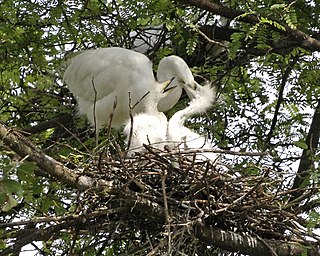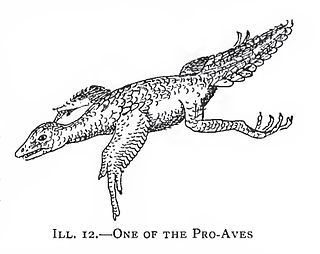 W
WThe evolution of birds began in the Jurassic Period, with the earliest birds derived from a clade of theropod dinosaurs named Paraves. Birds are categorized as a biological class, Aves. For more than a century, the small theropod dinosaur Archaeopteryx lithographica from the Late Jurassic period was considered to have been the earliest bird. Modern phylogenies place birds in the dinosaur clade Theropoda. According to the current consensus, Aves and a sister group, the order Crocodilia, together are the sole living members of an unranked "reptile" clade, the Archosauria. Four distinct lineages of bird survived the Cretaceous–Paleogene extinction event 66 million years ago, giving rise to ostriches and relatives (Paleognathae), ducks and relatives (Anseriformes), ground-living fowl (Galliformes), and "modern birds" (Neoaves).
 W
WThe scientific question of within which larger group of animals birds evolved has traditionally been called the 'origin of birds'. The present scientific consensus is that birds are a group of maniraptoran theropod dinosaurs that originated during the Mesozoic Era.
 W
WDarwin's finches are a group of about 18 species of passerine birds. They are well known for their remarkable diversity in beak form and function. They are often classified as the subfamily Geospizinae or tribe Geospizini. They belong to the tanager family and are not closely related to the true finches. The closest known relative of the Galápagos finches is the South American Tiaris obscurus. They were first collected by Charles Darwin on the Galápagos Islands during the second voyage of the Beagle. Apart from the Cocos finch, which is from Cocos Island, the others are found only on the Galápagos Islands.
 W
WEuornithes is a natural group which includes the most recent common ancestor of all avialans closer to modern birds than to Sinornis.
 W
WFeathers are epidermal growths that form distinctive outer covering, or plumage, on dinosaurs, both avian and some non-avian, and possibly other archosauromorphs. They are considered the most complex integumentary structures found in vertebrates and a premier example of a complex evolutionary novelty. They are among the characteristics that distinguish the extant birds from other living groups.
 W
WBirds are the group of amniotes with the smallest genomes. Whereas mammal and reptilian genomes range between 1.0 and 8.2 giga base pairs (Gb), bird genomes have sizes between 0.91 Gb and 1.3 Gb. Just as happens to any other living being, bird genomes’ reflect the action of natural selection upon these animals. Their genomes are the basis of their morphology and behaviour.
 W
WLack's principle, proposed by the British ornithologist David Lack in 1954, states that "the clutch size of each species of bird has been adapted by natural selection to correspond with the largest number of young for which the parents can, on average, provide enough food". As a biological rule, the principle can be formalised and generalised to apply to reproducing organisms in general, including animals and plants. Work based on Lack's principle by George C. Williams and others has led to an improved mathematical understanding of population biology.
 W
WParaves are a widespread group of theropod dinosaurs that originated in the Late Jurassic period. In addition to the extinct dromaeosaurids, troodontids, anchiornithids, and scansoriopterygids, the group also contains the avialans, among which are the over ten thousand species of living birds. Primitive members of Paraves are well known for the possession of an enlarged claw on the second digit of the foot, which was held off the ground when walking in some species.
 W
WProavis refers to a hypothetical extinct species or hypothetical extinct taxon and was coined in the early 20th century in an attempt to support and explain the hypothetical evolutionary steps and anatomical adaptations leading from non-avian theropod dinosaurs to birds. The term has also been used by defenders of the thecodontian origin of birds. The concept should not be confused with the genus Protoavis.
 W
WSexual selection in birds concerns how birds have evolved a variety of mating behaviors, with the peacock tail being perhaps the most famous example of sexual selection and the Fisherian runaway. Commonly occurring sexual dimorphisms such as size and color differences are energetically costly attributes that signal competitive breeding situations. Many types of avian sexual selection have been identified; intersexual selection, also known as female choice; and intrasexual competition, where individuals of the more abundant sex compete with each other for the privilege to mate. Sexually selected traits often evolve to become more pronounced in competitive breeding situations until the trait begins to limit the individual's fitness. Conflicts between an individual fitness and signaling adaptations ensure that sexually selected ornaments such as plumage coloration and courtship behavior are “honest” traits. Signals must be costly to ensure that only good-quality individuals can present these exaggerated sexual ornaments and behaviors.